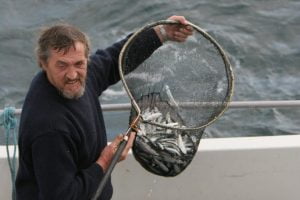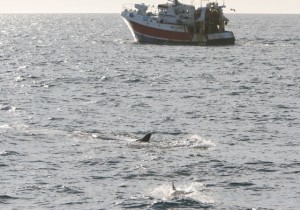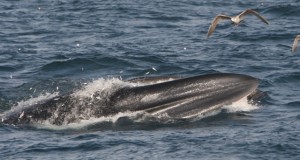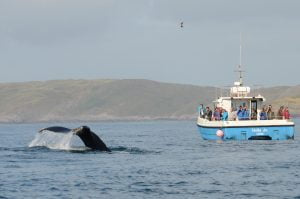For anyone following the discussion regarding the Irish government’s proposal to exclude large trawlers over 12 mts length fishing within 6 nautical miles of the coast, we hope that this article by Skipper Colin Barnes will help clarify, what we see as the issue, and why this exclusion goes ahead.
You might think it would be impossible to bring about the extinction of an abundant fish species, by unregulated fishing; as the assumption is that most fish are so widespread that you could never catch every last one. However, there are a few species that are not so widespread, but indigenous to a particular area. Good examples of this are herring and sprat.

Because of their abundance and commercial importance, herring have been the subject of much study and their ecology is well understood. Their exploitation is controlled with a quota system in place and a Total Allowed Catch is set each season based on scientific assessment of the status of the stocks available. But sprats are afforded no such protection. Because of their small size, they were never exploited commercially at any time in history, (other than a few small scale fisheries), so were never considered important enough to merit scientific study and there is surprisingly little known about their basic biology or ecology.
As an abundant and prolific plankton feeding forage fish, inhabiting the upper layer of the seas where plankton is most abundant, sprats are a vital link in the ocean ecology of the north east Atlantic. From the moment they hatch as tiny larva, just 2 or 3 millimetres in length, until they expire naturally 4 to 5 years later measuring around 12 centimetres, they provide a crucial food supply for almost every other fish species in our waters, as well as all oceanic birds, whales and dolphins. In other parts of the Atlantic this role would be filled by the likes of anchovies and sardines; all small, silvery fishes of very similar size, appearance and behaviour. For this reason they are the most important of all the ocean’s fishes, the prey of all predators.

Only in the last few decades, a fishery targeting sprats has developed that has brought them from great abundance to near extinction. The biggest of Ireland’s trawlers catch them using a huge mid-water trawl, pulled by two vessels, (usually referred to as pelagic or pair trawlers). Supported with an array of sophisticated fish detecting electronics, it is an extremely effective way of catching fish. Mackerel and herring are harvested by the same vessels using the same technique. Sprats are landed in bulk, for very low prices, and nearly all their landings are processed into fish-meal . Very little of the catch goes for human consumption. This fishery is completely unregulated, and subject to neither restriction nor quota, there is nothing to prevent their being overfished to extinction. A process that is now almost complete in West Cork’s coastal waters.
It is the spawning behaviour of sprats that makes them so vulnerable to overfishing, similar to herring. Throughout most of the year they are found at any depth in the water column, spread out over a wide area in local coastal waters, in relatively small shoals, grazing on zoo-plankton, and are too scattered to be economically targeted by large trawlers. But in late September and into October they begin to move inshore and assemble into large aggregations in preparation for spawning. All known spawning areas for sprat are in close to land. With receding hours of daylight and the sea temperature falling, the production of plankton slows right down, and the sprats stop feeding.
Plankton feeding forage fish, like sprat, herring and mackerel use the winter months, very efficiently, to carry out their spawning activity, when there is very little food available for them. Their digestive tract shrivels up and production of enzymes cease. This is to maximize the space in the body cavity for the production of roe in females and milt in males. This happens with many other fish species. Again, similar to herring, it is only when they are in this reproductive state that they are of any economic interest to commercial fishers; as they are full of roe and have a longer shelf-life for industrial processing, where they are converted into animal feed. This is the very time when they play their greatest role in the ecology of our coastal waters.
The sprat shoals loiter in the general area of their chosen spawning place, whilst their roe and milt develop rapidly, until all is ready for action. The shoals gradually merge together until there is usually just one or two huge gatherings of them in each spawning place. Finally, triggered by the turn of the tide, usually around a full moon in November or December, they pack together until there is hardly any water left between individual sprats. In great excitement, eggs stream continuously out of the females, whilst the males eject their white milt in such quantity that the sea appears milky. This is the only point where they differ from herring in that their eggs are scattered loose in mid water, whilst herring choose to stick theirs to the sea bed. A full moon ensures a big spring tide and plenty of water movement to scatter their eggs far and wide, making them less vulnerable to predation. As with herring, once their spawning is done, the huge shoals disperse quickly and move back out to sea, spent and hungry.
They can only targeted by pelagic/pair trawlers when they form into these very large, dense shoals directly prior to spawning. They return to the same locations, year upon year to reproduce, just as herring do, so are easily found and will not leave the area until they have spawned. At spawning time the entire stock of sprat are inshore, in bays, harbours and close to land, in super-dense slow moving shoals, – easy targets for sophisticated trawlers. There are no more sprats offshore or at any other place at this time, even the immature stock, not yet reproductive, assemble with the adult fish.
Persistent trawling of the shoaling adults every season has reduced the huge shoals to an all-time low with just scattered fragments of immature fish this year, and no sign of any spawning adults. In most of their favoured places there is no stock left at all. They are close to extinction in West Cork.
What makes for rich fishing grounds in all the world’s oceans, is a good supply of plankton and the forage fish that feed on it. A sea full of plankton without forage fish is good for neither man nor beast. A parallel in farming would be to remove all the feed from a chicken shed and see how many chickens you have left after a month or two. It can only lead to disaster. As a fisherman, angler and observer of all things aquatic during my life, I have watched with anguish and dismay, the process of sprats being squeezed out of existence by a small number of large trawlers over the last 30 years or so.
I began commercial fishing in West Cork waters in 1973, when sprats had never been subjected to any fishing

pressure and were consequently very abundant. In the autumn and early winter, every West Cork bay and harbour held vast amounts of sprat, where they assembled to spawn. Their presence was always of great interest to me, because of the variety of marine wildlife they attracted, notably dolphins in hundreds, sometimes thousands, a diversity of oceanic birds, not to mention the large whales, which today have helped put southwest Ireland firmly on a shortlist of one of the best places in the North Atlantic to observe species such as humpback and fin whales.
The harbour area of Glandore and Union Hall once held a huge amount of sprats. Every year in November /December the harbour was solid with spawning fish, attended by a blizzard of gannets and kittiwakes. Then in a prolonged period of very stormy weather in the 1990’s, too rough for any other kind of fishing, the trawlers turned their attention to sprat in the sheltered harbour. Countless articulated lorries were filled with sprats over a week or two, until all were caught. The stock did not return or rebuild. There is no sign of any sprats at all there now. This suggests that sprat stocks are the same as herring, an indigenous sub-species, faithful to a particular place for spawning, and thus, vulnerable to extinction from fishing pressure.
By the end of the 1970’s, mid-water/ pelagic trawling was firmly established as a successful technique for catching herring. Then, as the herring became scarce and subject to quotas, the trawlers turned their attention to sprats and discovered how easily caught they were. The local indigenous herring stock that spawned off Toe head, was fished to extinction by the 1990’s after receiving the same pressure from pelagic trawlers over the previous twenty years. The “Toe Head herring” was a stock that had survived through centuries of recorded fishing history, and presumably for millennia before that. Not a word was ever said or written about this extinction event, it passed unnoticed. Are sprats now facing a similar fate?

It is sad to witness year on year, the ever decreasing sprat biomass, to the point they are at now – almost gone. Equally sad too, is how the fin and humpback whales have reacted to this change. Fin whales that once graced the waters of West Cork in such impressive numbers in years gone by, to gorge on this seasonal bonanza, have slowly dwindled to very low numbers in response. For the 2017 season, just a single fin whale showed up now and again and there was a brief appearance of a single humpback for the tiny amount of sprats that were present in the former spawning grounds. Common dolphins once in thousands are down to just a few hundred. Their prey is gone and the predators are “voting with their fins”.
All the fish species in coastal waters that prey upon sprat have now decreased dramatically in numbers as well. With

no prey around, fish drift away in search of food elsewhere, some will starve to death, many become cannibalistic, eating their own or the larva of other species, rather than starve. Without a doubt, there are far less fish around in West Cork’s coastal waters since the sprat were thinned out. To maintain healthy and abundant fish stocks, it is essential to have forage fish present, and sprats and sandeels are the most important of these in Irish waters, and indeed all north east Atlantic waters. These large pelagic trawlers systematically removing sprats are destroying the viability of the whole fishing industry, not to mention the impact on local marine ecotourism, angling and marine wildlife watching operations, which all contribute to the local economy.
I have endeavoured to raise my concerns with the powers that be over a number of years now, but to no avail. I wrote more than once to Simon Coveney, the then Minister with responsibility for fisheries and more recently to the current minister Michael Creed. The standard replies I received suggest that neither the ministers nor their fisheries advisors understand the problem, or that there is a problem that requires immediate action. In one reply I was informed that sprats were only being fished after spawning had taken place- which is totally incorrect, and that all fishing activity in Irish waters in the future will be sensible and sustainable. There is nothing sensible or sustainable about sweeping up every last shoal of sprat as they assemble to spawn.
This situation is indicative of the poor management in place over European fisheries. American fishing is controlled by a number of regional fishery management councils, and in recent years through good oceanic study and science, they have come to recognise the importance of forage fishes and are taking steps to control or stop their exploitation. They are surprisingly well ahead of Europe in this regard. Marine fishery management in Europe has been pitiful and ineffective to date. The rights and wrongs of forage fish exploitation hasn’t even been an issue worthy of discussion in Europe as far as I am aware. There is plenty that could be done to improve our fish stocks, starting with meaningful conservation measures to prevent any further exploitation of forage fish like sprats. They are worth so much more alive than dead.
Although I am writing primarily about my experience of the situation in West Cork’s waters, I have received correspondence from as far east as Wexford and as far north as Donegal, regarding the over-exploitation of local sprat stocks by large pelagic/pair trawlers. This is a nationwide concern that stretches well beyond the boundaries of West Cork’s once biologically rich waters.
In conclusion, it is our considered opinion that the proposed introduction of restrictions within a 6 mile limit, would provide total protection for this endangered stock and hopefully allow a recovery where there are any left. Any loss of earning to the relatively few large boats engaging in this destructive fishery will be adequately compensated by an increase in commercial species available to them. It will also send out a strong message that Ireland Inc. cares deeply about the coastal communities who live along and depend on the Wild Atlantic Way having a properly functioning marine ecosystem.
When not all evidence is available, scientists err on the side of caution. This is known as the Precautionary Principle. Application of this principle is needed now, if we are serious about protecting our marine environment.
Colin Barnes and Pádraig Whooley, Cork Whale Watch
The consultation paper entitled ‘Trawling Activity inside the 6 Nautical Mile Zone’, along with referenced reports and analysis, are available at the relevant link on the Public Consultations page of the Department’s website at www.agriculture.gov.ie/customerservice/publicconsultations The consultation period will run until Monday 11th June 2018.
“If this issue concerns you, please write to the Minister voicing your concerns…..this is your opportunity to make a difference.”





Well said Colin !!
Great piece Colin, well done.
I’ve written to the Minister.
I hope others do the same, this needs to be sorted quickly.
Best Tom
Great article Colin and Padraig and as a Birder of nearly 50 years and seawatcher those large fishing frenzies during the winter months are now ever so rare sadly.
John
Me too ! It’s about time that our leaders ( politicians) in Parliament realise that we put them there to help us and not the opposite. They just don’t get it – yet – that we are only the leaseholders of this planet, not the freeholders.The next time that they ask for your vote, please ask them about their environmental policy, and as you know they only ask about once every five years !
Mike Cobley
Can you provide a link for the DOM consultation?
Research on traditional fishing knowledge in west of Ireland fishing communities recorded that older fishermen were of the opinion that one thing the British navy did right was enforcing fish nursery areas where all types of netting was forbidden, only long line fishing (aka spillet fishing) was allowed.
A very intresting and informitv read
I’ll be sharing on social media to get more fisher men to understand the importance of our sprat stocks.
There are still an abundance of sprats and herrings in our bays. Your article is full of shit
Presumably you have some evidence for this? And if you do, then you clearly know more than Celtic Sea Herring Advisory Council who have recommended the closure of the herring fishery this year due based on sample low catches. As for sprat down here in West Cork…..as a stock, they are as good as wiped by large pair trawlers, in the very same way as the Stag Sound herring stock were wiped out systematically in the 1970’s & 80’s. This too was denied at the time by local fishing interests, and of course now that it’s too late, in private anyway, they’d have no problem telling you that they knew exactly what they were doing as all that mattered was the bottom line. What a shame that this once thriving industry has such myopic vision and seems to care less about the wider coastal community. Forage fish like sprat are way too important for marine ecology to be processed for fishmeal, which is where almost all of it goes. Hopefully the ban on these big industrial boats will not come too late for what is left of our sprat stocks.